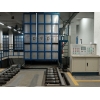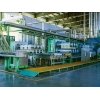What are the commonly used spinning methods?
According to the different properties of fiber-forming polymers, the spinning methods of chemical fibers mainly include melt spinning and There are two major types of melt spinning, and there are also special or unconventional spinning methods. Among them, according to the different solidification methods, the melt spinning method is divided into wet spinning and dry spinning. In the production of chemical fibers, most of them are produced by melt spinning, followed by wet spinning, and only a few are produced by dry or other unconventional spinning methods.
One. Melt spinning method
Melt spinning method is to quantitatively extrude the spinning melt through a screw extruder and a spinning pump to extrude the spinneret into the air in a thin stream. And cooling in the spinning tunnel into filaments. At present, the spinning speed of the melt spinning method is generally 1000-2000 m/min. When adjusting spinning, it can reach 4000~6000m/min. Number of spinneret holes: 1 to 150 holes for filaments, 400 to 800 holes for short fibers, and 1000 to 2000 holes for more. The diameter of the spinneret is generally 0.2 to 0.4 mm.
The main features of the melt spinning method are high winding speed, no need for solvents and precipitants, simple equipment and short process flow. It is an economical, convenient and efficient forming method. However, the number of spinneret holes is relatively small. In recent years, on the basis of digesting and absorbing the imported technology, our country has developed low-speed porous and high-speed short-distance spinning to produce polypropylene and polyester. Polyester, nylon and polypropylene in synthetic fibers are all spun by melt spinning.
Second. Solution spinning method
1. Wet spinning Wet spinning is to extrude the spinning melt obtained by the solution method from the pores of the spinneret into a fine stream, and then put it in the coagulation liquid. solidified into silk. Due to the slow solidification of the thread, the spinning speed of wet spinning is low, generally 50-100 m/min, and the number of holes in the spinneret is more than that in melt spinning, generally 4000-2000 holes. The cross-section of the fibers obtained by the blended spinning method is mostly non-circular and has a relatively obvious skin-core structure, which is mainly caused by the solidification of the coagulation liquid.
Wet spinning is characterized by complex process flow, large casting times, low spinning speed and high production cost. Generally, in the production of short fibers, a multi-hole spinneret or a cascade of spinneret holes can be used to improve the production capacity, thereby making up for the defect of low spinning speed. Generally, fiber-forming polymers that cannot be melt-spun are wet-spun and produced into staple fibers and filament tow. Acrylic, vinylon, vinyl and viscose are mostly wet spinning.
One. Melt spinning method
Melt spinning method is to quantitatively extrude the spinning melt through a screw extruder and a spinning pump to extrude the spinneret into the air in a thin stream. And cooling in the spinning tunnel into filaments. At present, the spinning speed of the melt spinning method is generally 1000-2000 m/min. When adjusting spinning, it can reach 4000~6000m/min. Number of spinneret holes: 1 to 150 holes for filaments, 400 to 800 holes for short fibers, and 1000 to 2000 holes for more. The diameter of the spinneret is generally 0.2 to 0.4 mm.
The main features of the melt spinning method are high winding speed, no need for solvents and precipitants, simple equipment and short process flow. It is an economical, convenient and efficient forming method. However, the number of spinneret holes is relatively small. In recent years, on the basis of digesting and absorbing the imported technology, our country has developed low-speed porous and high-speed short-distance spinning to produce polypropylene and polyester. Polyester, nylon and polypropylene in synthetic fibers are all spun by melt spinning.
Second. Solution spinning method
1. Wet spinning Wet spinning is to extrude the spinning melt obtained by the solution method from the pores of the spinneret into a fine stream, and then put it in the coagulation liquid. solidified into silk. Due to the slow solidification of the thread, the spinning speed of wet spinning is low, generally 50-100 m/min, and the number of holes in the spinneret is more than that in melt spinning, generally 4000-2000 holes. The cross-section of the fibers obtained by the blended spinning method is mostly non-circular and has a relatively obvious skin-core structure, which is mainly caused by the solidification of the coagulation liquid.
Wet spinning is characterized by complex process flow, large casting times, low spinning speed and high production cost. Generally, in the production of short fibers, a multi-hole spinneret or a cascade of spinneret holes can be used to improve the production capacity, thereby making up for the defect of low spinning speed. Generally, fiber-forming polymers that cannot be melt-spun are wet-spun and produced into staple fibers and filament tow. Acrylic, vinylon, vinyl and viscose are mostly wet spinning.




